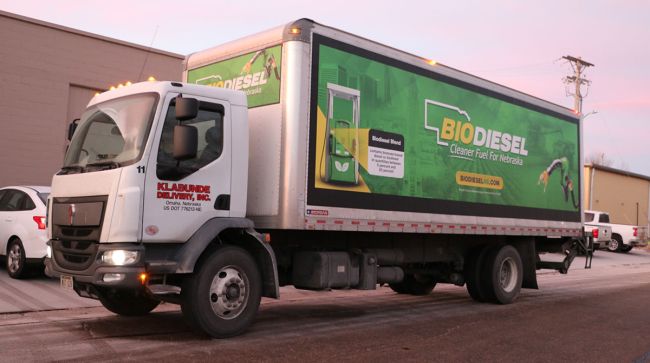Nine delivery trucks were wrapped with the banner saying, “Biodiesel, cleaner fuel for Nebraska.” (Nebraska Soybean Board)
A trucking campaign promoting biodiesel fuel to easily lower carbon emissions by the state soybean farmers has been such a success in raising awareness it may be repeated.
For four months ending in April, nine delivery trucks wrapped with green-colored ads saying “Biodiesel, cleaner fuel for Nebraska” traveled through the state’s largest cities and across Interstate 80 between North Platte, Kearney and Grand Island.
“We received many positive comments and pictures from folks of the trucks out on the roads of Lincoln, Omaha and in the western part of the state. We wanted to inform drivers in Lincoln, Omaha and those driving on I-80 in Nebraska of the benefits of biodiesel regarding health, the economy, the environment and benefits to farmers,” said Tom Hoxmeier, communications coordinator at the nonprofit Nebraska Soybean Board.
“[The fuel’s] compatibility with existing diesel engines and infrastructure makes it an easily adoptable option for the trucking industry, facilitating a transition toward cleaner and greener transportation solutions,” he added.

Hoxmeier
Noting that biodiesel is a win-win for the trucking industry and farmers, the association notes that biodiesel can reduce life cycle emissions by 86% compared with petroleum-based diesel fuel and it adds 70 cents per bushel to the value of soybeans.
“Increased demand for soybean oil to make biodiesel also increases the supply of soybean meal, leading to lower animal feed prices paid by poultry and livestock farmers,” according to the state of Nebraska. “Heavy-duty diesel vehicles can also lower emissions by filling up with biodiesel blends of 20% (B20) or higher.”
Did You Know?
• One bushel of soybeans can make 1.5 gallons of biodiesel.
• Soybeans account for 90% of all U.S. oilseed production.
• The United States is the world’s leading soybean producer and the second-leading exporter.
Soybean oil used in biofuel production is projected to increase by 900 million pounds in the 2023-24 market year to 12.5 billion pounds, stated an “Oil Crops Outlook” report in May by the U.S. Department of Agriculture’s Economic Research Service.
Hoxmeier said 30,000 to 70,000 people each day saw the truck messaging about biodiesel. The association’s board has not voted on the issue of another run, but he said it may rerun the campaign during the next fiscal year. A total of some 25.8 million people saw the truck-side advertising campaign.
“It’s going to reduce emissions, it’s clean-burning and it’s a win-win for farmers.” Sherry Vinton, Director of @NeDeptAg discusses the importance of renewable fuels in the state of Nebraska. #RenewableFuelsMonth @NECornBoard @NE_ethanol @RFNebraska pic.twitter.com/3YvCd6aDJa
— Nebraska Soybean Board (@NESoybeanBoard) May 30, 2023
“We want to emphasize the value and unique opportunity of biodiesel among other clean and renewable fuels that are perfectly suited for diesel trucks,” Hoxmeier said. “By adopting biodiesel or other clean fuels, you not only reduce emissions and improve air quality but also support domestic agriculture and local economies.”
He also wanted to express this message to the trucking industry from the state’s soybean leaders and growers.
“The Nebraska Soybean Board and Nebraska soybean farmers extend our appreciation for invaluable contributions of our national trucking community,” he added.
After corn, soybeans are Nebraska’s second-largest harvested crop. The state’s farmers last year produced 278.3 million bushels of soybeans.
AGP broke ground on a new soybean processing facility. This plant will allow Nebraska to keep more topsoil in our state so we can process, package, and ship finished ag products around the world. pic.twitter.com/GMDfzmosPs
— Governor Jim Pillen (@TeamPillen) May 18, 2023
In fact, last month Gov. Jim Pillen declared May as “Renewable Fuels Month” in Nebraska during a May 4 proclamation ceremony at the state Capitol. Renewable Fuels Month was to celebrate the crucial role renewable fuels play in the state’s economy, environment and energy security.
The state international trade office describes soybeans as among the most versatile major crops that can be grown in a wide variety of soils and climates. Also ideal in crop rotation, farmers switch from corn to soybeans, which return nitrogen back into the soil. Not only used in renewable fuel, soybean seeds (beans) are processed for use in animal feed, human food products and industrial goods such as ink, coatings, solvents, plastics, lubricants and adhesives.






